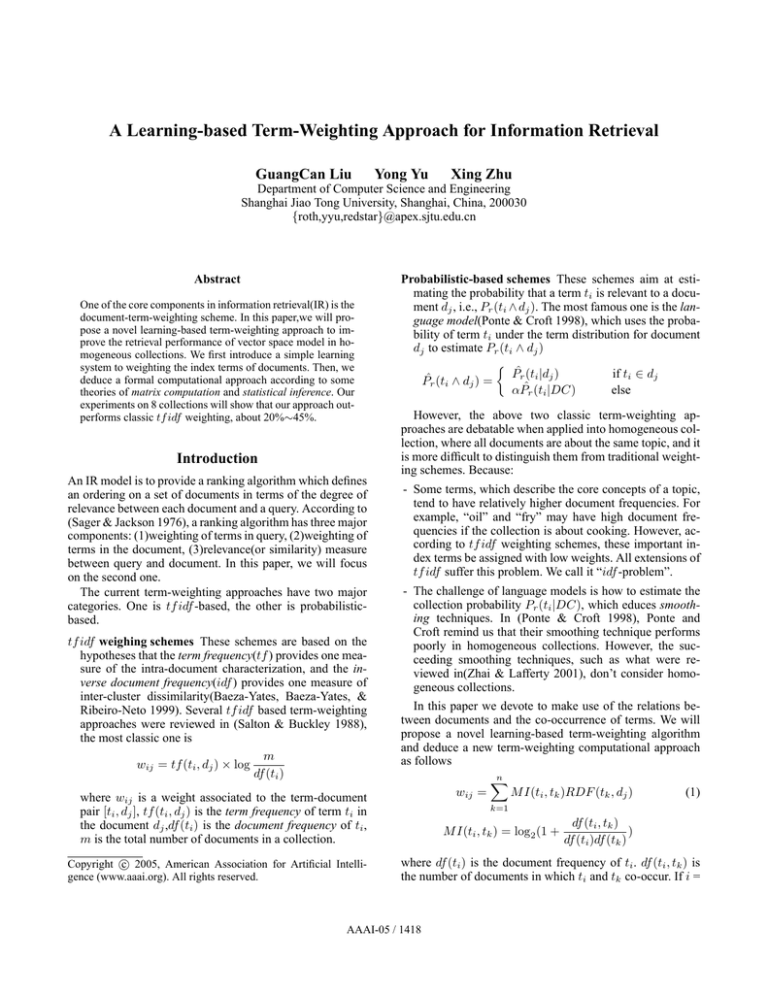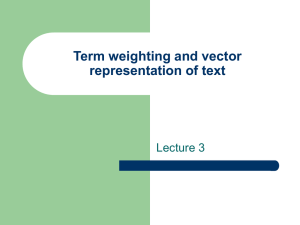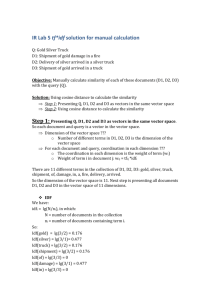
A Learning-based Term-Weighting Approach for Information Retrieval
GuangCan Liu
Yong Yu
Xing Zhu
Department of Computer Science and Engineering
Shanghai Jiao Tong University, Shanghai, China, 200030
{roth,yyu,redstar}@apex.sjtu.edu.cn
Abstract
One of the core components in information retrieval(IR) is the
document-term-weighting scheme. In this paper,we will propose a novel learning-based term-weighting approach to improve the retrieval performance of vector space model in homogeneous collections. We first introduce a simple learning
system to weighting the index terms of documents. Then, we
deduce a formal computational approach according to some
theories of matrix computation and statistical inference. Our
experiments on 8 collections will show that our approach outperforms classic tf idf weighting, about 20%∼45%.
Introduction
An IR model is to provide a ranking algorithm which defines
an ordering on a set of documents in terms of the degree of
relevance between each document and a query. According to
(Sager & Jackson 1976), a ranking algorithm has three major
components: (1)weighting of terms in query, (2)weighting of
terms in the document, (3)relevance(or similarity) measure
between query and document. In this paper, we will focus
on the second one.
The current term-weighting approaches have two major
categories. One is tf idf -based, the other is probabilisticbased.
tf idf weighing schemes These schemes are based on the
hypotheses that the term frequency(tf ) provides one measure of the intra-document characterization, and the inverse document frequency(idf ) provides one measure of
inter-cluster dissimilarity(Baeza-Yates, Baeza-Yates, &
Ribeiro-Neto 1999). Several tf idf based term-weighting
approaches were reviewed in (Salton & Buckley 1988),
the most classic one is
m
wij = tf (ti , dj ) × log
df (ti )
Probabilistic-based schemes These schemes aim at estimating the probability that a term ti is relevant to a document dj , i.e., Pr (ti ∧ dj ). The most famous one is the language model(Ponte & Croft 1998), which uses the probability of term ti under the term distribution for document
dj to estimate Pr (ti ∧ dj )
½
Pˆr (ti |dj )
if ti ∈ dj
Pˆr (ti ∧ dj ) =
αPˆr (ti |DC)
else
However, the above two classic term-weighting approaches are debatable when applied into homogeneous collection, where all documents are about the same topic, and it
is more difficult to distinguish them from traditional weighting schemes. Because:
- Some terms, which describe the core concepts of a topic,
tend to have relatively higher document frequencies. For
example, “oil” and “fry” may have high document frequencies if the collection is about cooking. However, according to tf idf weighting schemes, these important index terms be assigned with low weights. All extensions of
tf idf suffer this problem. We call it “idf -problem”.
- The challenge of language models is how to estimate the
collection probability Pr (ti |DC), which educes smoothing techniques. In (Ponte & Croft 1998), Ponte and
Croft remind us that their smoothing technique performs
poorly in homogeneous collections. However, the succeeding smoothing techniques, such as what were reviewed in(Zhai & Lafferty 2001), don’t consider homogeneous collections.
In this paper we devote to make use of the relations between documents and the co-occurrence of terms. We will
propose a novel learning-based term-weighting algorithm
and deduce a new term-weighting computational approach
as follows
wij =
where wij is a weight associated to the term-document
pair [ti , dj ], tf (ti , dj ) is the term frequency of term ti in
the document dj ,df (ti ) is the document frequency of ti ,
m is the total number of documents in a collection.
c 2005, American Association for Artificial IntelliCopyright °
gence (www.aaai.org). All rights reserved.
n
X
M I(ti , tk )RDF (tk , dj )
(1)
k=1
M I(ti , tk ) = log2 (1 +
df (ti , tk )
)
df (ti )df (tk )
where df (ti ) is the document frequency of ti . df (ti , tk ) is
the number of documents in which ti and tk co-occur. If i =
AAAI-05 / 1418
k, df (ti , tk ) = df (ti ) = df (tk ). M I(ti , tk ) is an estimation
of the mutual information(Church & Hanks 1990) between
ti with tk . tk ∈ T S, T S denotes the index term space of the
whole collection. n is the total number of terms in the whole
collection.
RDF (tk , dj ) denotes the number of the documents not
only relevant to dj but also containing the term tk , i.e., the
relevant document frequency (RDF ) of tk with regard to
dj . For example, there are d1 , d2 , d3 and d4 in the collection which are relevant to dj . tk appears in documents d1 ,
d2 , then RDF (tk , dj ) = 2. It is a measure of the relevance
degree of tk and dj .
The production of M I(ti , tk ) and RDF (tk , dj ) can be
considered as a measure of the relevance degree of ti and
dj with considering a “medi-term” tk , which forms our approach basis. A term which does not appear in a documents
may still be related to the document. Our approach can find
the relevance relationships through another medi-term. But
only considering few medi-terms is not enough, which is
supported by our experimental results (See table 4).
Example 1 simply demonstrates the computational process of our approach.
Example 1. Assume there are a 3-document collection DC
= {d1 , d2 , d3 }. d1 = {satellite}, i.e., d1 has only one term
“satellite”. d2 = {launch}. d3 = {satellite, launch}. Let t1
= “satellite”, t2 = “launch”, then
df (t1 ) = 2, df (t2 ) = 2, df (t1 , t2 ) = 1
1
M I(t1 , t1 ) = M I(t2 , t2 ) = log2 (1 + ) = 0.5850
2
1
M I(t1 , t2 ) = log2 (1 + ) = 0.3219
4
Problem Definition
In homogeneous collections, where exist strong relations between documents. If a term t is important to a document d,
it may appear frequently in the relevant documents of d and
appear seldom in the irrelevant documents. We target to assign high weights to these terms and low weights to the others. In our work, document dl is relevant to document dm if
and only if
→
− −→
dl .dm
sim(dl , dm ) = q
> simT H
(2)
−
→ −→
| dl ||dm |
−
→
where dl = (w1l , ..., wnl ), wil is weighted according to
tf idf scheme. simT H is the threshold.
Suppose we have known: (1)The term set (or contents) of each document, i.e., we know whether a term
appear in a document or not. (2)The relevance relationships between documents, i.e., we know whether two documents are relevant or not. The problem will be to determine a proper weight wij associated with each termdocument pair [ti , dj ] so that the retrieval performance can
be improved. This mechanism is somewhat similar with
relevance-feedback(Harman 1992) which can improve the
effectiveness of IR systems. The difference is that we use
the relevance relationships between documents.
Weighting Through a Learning Process
Assume document d1 is relevant to d3 1 , but irrelevant to d2 ,
then
RDF (t1 , d1 ) = 2, RDF (t2 , d1 ) = 1
For document d1
w11 = M I(t1 , t1 )RDF (t1 , d1 ) + M I(t1 , t2 )RDF (t2 , d1 )
= 0.5850 × 2 + 0.3219 × 1 = 1.4919
w21 = M I(t2 , t1 )RDF (t1 , d1 ) + M I(t2 , t2 )RDF (t2 , d1 )
= 0.3219 × 2 + 0.5850 × 1 = 1.2288
Each term-document pair is assigned a weight. Although
“launch” does not appear in d1 , it is still assigned a weight
1.2288. These weights act as “smoothing” technique to improve the performance of our approach.
In the following discussion, we will focus on the deduct of
this computational approach. The remains of this paper are
organized as follows: Firstly, we introduce a simple learning
system to weighting and the definition of our target. Then,
we deduce a formal computational approach according to
some theories of matrix computation(Modi 1989) and statistical inference. At last, we apply our approach to improve
the retrieval performance of vector space model(VSM). Our
1
experiments will show that our approach outperforms classic
tf idf weighting (about 20% ∼ 45%) on 8 different homogeneous collections.
We will discuss how to discover relevance relationships between documents later. Obviously, a document is also relevant to
itself.
We define an output function based on linear unit (Mitchell
1999) for each document dj
−
→→
fdj (xl ) = dj −
xl = w1j x1l + . . . + wnj xnl
−
→
where xl is a n-dimensional vector representing an example
→
xl , −
xl = (x1l , ..., xnl ).
We use some documents as examples to train over each
document dj . Each example-document2 is marked as xl , rep→
resented by a binary weight vector −
xl = (x1l , ..., xnl ), where
½
1
if ti ∈ xl
xil =
(3)
0
else
We define target output for each example xl as
½
1
if xl is relevant to dj
ydj (xl ) =
0
else
(4)
→
−
To determine the weight vector dj , the learning process
should make the outputs fit the target outputs so as to solve
the following inconsistent equation (Manna 2003)
ydj (x1 )
x11 . . . xn1
w1j
x12 . . . xn2 w2j ydj (x2 )
.
.
= .
..
..
..
..
.
.
.
.
x1m . . . xnm
wnj
ydj (xm )
2
A document which is used as a training example.
AAAI-05 / 1419
where n is size of index term space. m is the training exam→
ples amount. Let X=[xuv ]m×n , −
y =(ydj (x1 ), ..., ydj (xm )),
the equation above is equal to
−
→T →T
X dj = −
y
(5)
Example 2 The same settings with example 1. We select
the whole collection as a sample 3 : S = {x1 , x2 , x3 }, x1 =
d1 , x2 = d2 , x3 = d3 . The training examples are presented
−
→1 = (1, 0), x
−
→2 = (0, 1), x
−
→3 = (1, 1).
as: x
For document d1 : yd1 (x1 ) = 1, yd1 (x2 ) = 0, yd1 (x3 ) = 1.
−
→
Then, to determine the weight vector d1 = (w11 , w21 ) is
equal to solve the following inconsistent equation
"
#
¸ " 1 #
1 0 ·
w11
0 1
= 0
w21
1 1
1
To solve the inconsistent equation 5, the RGDS (Random
Gradient Descent Search) algorithm devotes to minimize the
following training error(Mitchell 1999)
1X
−
→
E(dj ) =
(ydj (xl ) − fdj (xl ))2
2
∀xl
i,e., to solve the following optimization equation
−
→T
−
→T →T
dj = arg min kX β − −
y k
→
−T
β
(6)
b = ω −1 D, and
where I is the unit matrix, L = ωED−1 , D
0 < ω < 2 is a relaxation parameter(Modi 1989). Let ω=1,
then the element lij of the matrix L is
(
df (ti ,tj )
df (ti ,tj )
if i < j
df (tj ,tj ) = df (tj )
lij =
0
else
Generally speaking, df (ti , tj ) ¿ df (tj ). Therefore, according to(Benzi & Tuma 1999)
+∞
n−1
X
X
(I − L)−1 =
Lk =
Lk ≈ I + L
k=0
where η is the learning speed. This process continues until
the minimum error is reached. Obviously, the terms which
appear frequently in the relevant documents (the target output is 1) will be assigned higher weights, and vice versa.
However, the computational complexity of the process is
too high. So we deduce another more efficient computational
approach as discussed in the next section.
Deduce a Computational Approach
According to Matrix Theory
As shown in(T. Hastie & Friedman 2001), the solution for
the equation 6 is
−
→T
−
dj = (X T X)−1 X T →
yT
(7)
To facility our discussion, we assume select the whole collection as the training sample.
−
(1)Consider the detail of X T →
y T which is a nT
T−
dimensional vector. Let X →
y = (r1j , ..., rnj )T , where rij
is associated with a term-document pair [ti , dj ]
xil × ydj (xl )
1
df (t1 , t2 )
df (t1 , tj )
, c12 =
, c1j =
df (t1 )
df (t1 )df (t2 )
df (t1 )df (tj )
for i ≤ j
df (t1 , ti )df (t1 , tj ) df (t2 , ti )df (t2 , tj )
+
+
cij =
df (t1 )df (ti )df (tj ) df (t2 )df (ti )df (tj )
df (ti−1 , ti )df (ti−1 , tj )
df (ti , tj )
... +
+
df (ti−1 )df (ti )df (tj )
df (ti )df (tj )
According to(Church & Hanks 1990), and C is a symmetrical matrix. Then, for ∀i, j
df (ti , tj )
cij ≈ log2 (1 +
) = M I(ti , tj )
df (ti )df (tj )
i.e.,
(X T X)−1 ≈ [M I(ti , tj )]n×n
(10)
(3)Integrate equation 7, 8 and 10. For document dj , its
−
→
weight vector dj = (w1 j, ..., wn j) is
w1j
M I(t1 , t1 ) . . . M I(t1 , tn )
w2j M I(t2 , t1 ) . . . M I(t2 , tn )
.
= .
..
..
..
..
.
.
c11 =
wnj
l=1
The production of xil and ydj (xl ) is non-zero if and only
if xil = 1 and ydj (xl ) = 1. xil = 1 denotes that ti ∈ dl .
3
k=0
b −1 (I + L)
(X T X)−1 ≈ (I + LT )D
b −1 (I +L) = [cij ]n×n , expand this matrix
Let C = (I +LT )D
wij ← wij + η(ydj (xl ) − fdj (xl ))xil
rij =
l=1
Let X T X = E + D + E T be the splitting of X T X into
its strictly upper triangular, diagonal, and strictly lower triangular part. According to(Fischer et al. 1996)(Bietenholz
)(Benzi & Tuma 1999)
b −1 (I − L)−1
(X T X)−1 ≈ (I − L)−T D
(9)
Then
The RGDS algorithm works as(Mitchell 1999)
m
X
ydj (xl ) = 1 denotes that dl is relevant to dj . Therefore, rij
denotes the number of documents which not only relevant to
dj but also contain ti . i.e.,
rij = RDF (ti , dj )
(8)
T
T
(2)Consider the detail of the matrix X X, Let X X =
[mij ]n×n
m
X
mij =
xil xjl = df (ti , tj )
A set of examples.
AAAI-05 / 1420
M I(tn , t1 )
...
M I(tn , tn )
RDF (t1 , dj )
RDF (t2 , dj )
×
...
RDF (tn , dj )
Then, the weight wij associated to term-document pair
[ti , dj ] is
wij =
n
X
M I(ti , tk )RDF (tk , dj )
(11)
k=1
In the following discussion we present another deduct of this
approach according to statistical inference.
According to Statistical Inference
For a document dj , according to the inference network(Turtle & Croft 1991)(Turtle & Croft 1990), the probability of a
query q is relevant to dj can be measured by
Pr (q ∧ dj ) =
n
X
P r(q|tk )P r(tk |dj )P r(dj )
Efficiency Improvement
As shown in equation 1, we need to consider each term as the
medi-term when weighting for a term-document pair. However, this is not necessary. Some terms which appear seldom are negligible when used as medi-terms. Because they
co-occur seldom with other terms, i.e., low M I value. The
RDF value can not be high if a term appear seldom. These
seldom appear terms are useless in statistics which form the
basis of our approach.
We just need to select some core-terms as the medi-terms.
As mentioned above, these core terms with relatively high
document frequency describe the core concepts of a topic.
Based on this, we select N terms which with highest document frequency as the “core space”: CS = {c1 , ..., cN }.
The weighting algorithm needs a small change
k=1
Let q be a single term ti
n
X
Pr (ti ∧ dj ) =
P r(ti |tk )P r(tk |dj )P r(dj )
wij =
M I(ti , ck )RDF (ck , dj )
(16)
k=1
(12)
Apply to Information Retrieval
k=1
Generally speaking, Pˆr(dj ) =
where |DC| is the size
of the collection. In the following discussion, we devoted to
estimate P r(ti |tk ) and P r(tk |dj ).
For a document dj , let p be “the probability of a term tk
appears in the relevant documents of dj ”, then
1
|DC| ,
Pr (RDF (tk , dj ) = r) = Cnr pr (1 − p)n−r
where n is the total number of document where tk appears,
i.e., n = df (tk ). This is based on the assumption that all
documents are either relevant to dj or not. We use the estimation of p to estimate P r(tk |dj )
RDF (tk , dj )
Pˆr (tk |dj ) = p̂ =
(13)
df (tk )
The same to above, let q be the “probability of the term ti
co-occur with tk inside documents ”. We use the estimation
of q to estimate the P r(ti |tk )
df (ti , tk )
Pˆr (ti |tk ) = q̂ =
df (ti )
Integrate the equation 12, 13 and 14
ki ∈q∩dj
where wij is calculated with equation 16.This ranking algorithm is called inner product measure(Salton 1971). ki ∈
q ∩ dj denotes that, we just need to weighting the terms
which appears in dj , i.e., remove “non-appear” terms.
There also exist other reasons of that we remove nonappear terms: (1) Add new terms into a document can help
the users to find this document(improve “recall”), but the
inter-cluster dissimilarity will be reduced(decline “precision”). (2)Retrieval over a collection with equation 17, the
returned-documents of each test query will be exactly the
same with tf idf approach except a different ordering. Our
aim is to manifest that our weighting scheme is more accurate than traditional tf idf scheme.
About Normalization
n
1 X
M I(ti , tk )RDF (tk , dj )
|DC|
We apply our approach to VSM. The degree of relevance
between the document dj and the query q is measured by
X
rel(dj , q) =
wij
(17)
(14)
df (ti , tk )
df (ti , tk )
≈ log2 (1 +
)
df (ti )df (tk )
df (ti )df (tk )
Pˆr (ti ∧ dj ) ≈
N
X
(15)
k=1
1
. So
This is the same to equation 12 except a constant |DC|
the wij computed with equation 1 is a measure of relevance
degree of ti and dj . This support the analysis about M I and
RDF at the beginning of this paper.
We deduce the same computational approach according to
two different theories. One is based on machine learning, the
other is based on statistical inference. This is not just coincidence. In fact, it has been proved that probabilistic-based
IR models can be considered as an application of learning
process(Chen 1995).
Another popular ranking algorithm of VSM is the cosine
measure(Salton 1971), which normalizes the weight vector
before using the inner product measure. The normalization
can improve the retrieval effectiveness. However, normalization in our approach must be executed carefully. Because all
terms can be assigned weights to a document, non-appear
terms of the document must be took into account. We do as
follows
(1)For a document dj , let Bdj = CS ∪ dj , i.e., combine dj
and CS into a new term set.
(2)For a term ti ∈
/ Bdj , wij = 0, otherwise, compute wij
with equation 16.
(3)Normalize the weight vector as follows
q wij
, if ti ∈ dj
P
2
wkj
tk ∈Bd
j
ŵij =
0,
else
AAAI-05 / 1421
Topic
EN
IE
IF
IP
IR
LG
MB
ST
Docs Num
2289
5315
1449
2764
3127
2495
2575
4852
Terms Num
52563
63132
29396
46253
47318
56152
63821
73659
N
6000
8000
4000
5000
5000
6000
7000
8000
simT H
0.12
0.12
0.12
0.12
0.12
0.12
0.12
0.12
Table 1: Statistics of the 8 collections and corresponding parameters setting. where N denotes the size of the concept
space, simT H is the relevance-document decision threshold in equation 2
Rec
0.0
0.1
0.2
0.3
0.4
0.5
0.6
0.7
0.8
0.9
1.0
avg
tf idf
0.9095
0.4846
0.3797
0.3207
0.2730
0.2349
0.1879
0.1507
0.1120
0.0706
0.0053
0.2846
NoSmo
0.9591
0.6042
0.4596
0.3804
0.3169
0.2705
0.2178
0.1735
0.1281
0.0794
0.0053
0.3268
M IRDF
0.9411
0.6397
0.5140
0.4393
0.3748
0.3174
0.2539
0.2006
0.1436
0.0874
0.0058
0.3561
Imp1
+03.48
+32.00
+35.37
+37.02
+37.26
+35.09
+35.09
+33.10
+28.22
+21.29
+09.43
+25.15
Imp2
-01.88
+05.87
+11.84
+15.51
+18.26
+17.35
+16.58
+15.62
+12.13
+10.15
+10.31
+08.99
Table 2: Test the impact of smoothing on TREC5-IE collection. “NoSmo” denotes without smoothing
where wij is computed with equation 16. We label this with
“smoothing”.
Example 3 In example 1. If we select the core space CS
= {launch}, then Bd1 = {satellite, launch}.
w11 = 0.3219 × 1 = 0.3219, w21 = 0.5850 × 1 = 0.5850
After normalization: w11 = 0.4821, w21 = 0.8761.
After remove non-appear term: ŵ11 = 0.4821, ŵ21 = 0.
If normalize the weight vector without considering the nonappear term “launch”. Then ŵ11 = 1, ŵ21 = 0. Because d1
contain only one term.
Our experiment will show that this smoothing technique
can improve the performance of our approach.
Topic
tf
tf idf
M IRDF
Imp
Topic
tf
tf idf
M IRDF
Imp
EN
0.2893
0.3103
0.3922
+26.40
IR
0.2478
0.2601
0.3732
+43.49
IE
0.2650
0.2846
0.3561
+25.15
LG
0.2759
0.2999
0.3834
+27.86
IF
0.2600
0.2756
0.4001
+45.21
MB
0.2873
0.3075
0.3690
+19.99
IP
0.2533
0.2708
0.3590
+32.55
ST
0.2734
0.2989
0.3603
+20.53
Table 3: Compare with tf idf on 8 collections with average
11-point average evaluation.
Experiments and Results
Test Data
TREC5 We use the 30 queries and related documents in
routing task of TREC5 to construct test data. These queries
have “domain” information and there are altogether 8 domains. The “domain” is used as topic in our experiments.
About 17000 documents belong to these 8 topics according
to query-result list. We construct 8 homogeneous collections
by using documents with the same topic.
MEDLINE There are 1033 documents and 30 test
queries. Each document is an abstract article on medicine.
Test the impact of smoothing on TREC5-IE IE denotes
the “International Economics” topic. We test the impact of
smoothing on this collection with 11-point average evaluation. In addition, we present the performance of tf idf with
11-point average evaluation.
Test the impact of core space on MEDLINE The total
number of terms in MEDLINE is 8702. The size of core
space is set as N = {500, 1000, 3000, 5000, 7000}. We test
the impact of the selection of core space CS with average
11-point average evaluation.
Experiments Setting
Compare with tf idf on TREC5 Compare our approach
with classic tf idf (which is presented at the beginning of
this paper) on 8 collections with average 11-point average
evaluation. Statistics of these collections and corresponding
parameters setting are presented in table 1. The 8 collections
are labelled with the abbreviation of their topic name. For
example,“IE” is the short for “International Economics”. N
denotes the size of core space, i.e., we select top N terms
from a term list sorted descending according to document
frequency.
In addition, we also present the performance of tf weighting scheme which has no idf -problem on homogeneous collections. But it is too simple to achieve good performance.
Results
(1)In table 2, we show the detail recall-precision information on IE collection. The results show a comprehensive improvement in precision compared with tf idf (labelled with
“Imp1”). At recall 0.1, improve about 32%. Improve about
25% in average. It is noticeable that, our approach with the
ranking algorithm (equation 17) don’t put any change to the
contents of returned-documents compared with tf idf except
their ordering.
The impact of smoothing is positive in this collection (labelled with “imp2”). It improve the precision at every levels
of recall except recall 0(decline about 2%) and with 8.99%
improvement in average.
(2)In table 3, we compare our approach with tf idf on 8
AAAI-05 / 1422
N
Avg
Imp
tf idf
0.504
500
0.541
+7.4
1000
0.564
+11.9
3000
0.572
+13.6
5000
0.573
+13.7
7000
0.574
+13.9
Table 4: Test the impact of the selection of concept space on
MEDLINE collection with average 11-point average evaluation(baseline: tf idf ), where N is the size of core space
homogeneous collections. Our approach outperform tf idf
with ranges of 19.99%∼45.21% with average 11-point average evaluation. tf weighting also perform poorly on these
homogenous collections although it has no idf -problem.
(3)Table 4 shows that the retrieval performance do not ascend along with the increasing of the size of core space.
When the core size N ≥ 1000, the retrieval performance
tend to be stable. M ean = 0.5706, Std.Dev = 0.0047. However, use a too small core space will reduce the performance.
When N = 500, the performance declines obviously compared with N = 1000. This offers support to that we can not
use too few medi-terms.
In MELINE collection, M IRDF also improve the performance, about 13% at most. The performance of tf idf is
also considerable in this collection.
In our experiments, the relevance decision threshold
simT H is set to 0.12 on all collections. We found the performance of our approach is not very sensitive to this parameter
when it locates in a space(0.08 ∼ 0.14).
Conclusion and Future Work
In this paper, we devote to solve the term-weighting challenge in homogeneous collections. By using relations between documents and terms, we could weighting terms
through a simple learning process. Then we deduce a computational approach accordingly. We also get the same calculation mechanism according to inference network, which
provides evidence of that probabilistic-based IR models can
be considered as an application of machine learning. One advantage of our approach is that non-appear terms can be assigned reasonable none-zero weights, while most traditional
approaches assign zero or random weights. In order to test
the effectiveness of our mechanism, we apply it to 8 collections constructed by TREC5 data. The experimental results
prove that it outperforms classic tf idf significantly.
There is still some work left. First, the estimation of
P (ti |dj ) is not proved strictly in this paper. Second, our
approach is not appropriate for heterogeneous collections
in which RDF values tend to be close for term-document
pairs, so that different terms can not be distinguished
clearly.
References
Proceedings on the on Iterative methods and preconditioners, 305–340. Elsevier North-Holland, Inc.
Bietenholz, E. Ssor preconditioning of improved actions.
Chen, H. 1995. Machine learning for information retrieval: neural networks, symbolic learning, and genetic algorithms. J. Am. Soc. Inf. Sci. 46(3):194–216.
Church, K. W., and Hanks, P. 1990. Word association
norms, mutual information, and lexicography. Comput.
Linguist. 16(1):22–29.
Fischer, S.; Frommer, A.; Glässner, U.; Lippert, T.;
Ritzenhöfer, G.; and Schilling, K. 1996. A parallel SSOR
preconditioner for lattice QCD. Computer Physics Communications 98:20–34.
Harman, D. 1992. Relevance feedback and other query
modification techniques. 241–263.
Manna, Z. 2003. Mathematical Theory of Computation.
Dover Publications, Incorporated.
Mitchell, T. M. 1999. Machine learning and data mining.
Commun. ACM 42(11):30–36.
Modi, J. J. 1989. Parallel Algorithms and Matrix Computation. Oxford University Press, Inc.
Ponte, J. M., and Croft, W. B. 1998. A language modeling approach to information retrieval. In SIGIR ’98: Proceedings of the 21st annual international ACM SIGIR conference on Research and development in information retrieval, 275–281. ACM Press.
Sager, W., and Jackson, D. 1976. Classification of ranking algorithms. International Forum on Information and
Documentation. 1:41–46.
Salton, G., and Buckley, C. 1988. Term-weighting approaches in automatic text retrieval. Inf. Process. Manage.
24(5):513–523.
Salton, G. 1971. The smart retrieval system-experiments
in automatic document processing.
T. Hastie, R. T., and Friedman, J. 2001. The Elements of
Statistical Learning: Data Mining, Inference, and Prediction. Springer Verlag.
Turtle, H., and Croft, W. B. 1990. Inference networks for
document retrieval. In SIGIR ’90: Proceedings of the 13th
annual international ACM SIGIR conference on Research
and development in information retrieval, 1–24. ACM
Press.
Turtle, H., and Croft, W. B. 1991. Evaluation of an inference network-based retrieval model. ACM Trans. Inf. Syst.
9(3):187–222.
Zhai, C., and Lafferty, J. 2001. A study of smoothing
methods for language models applied to ad hoc information retrieval. In SIGIR ’01: Proceedings of the 24th annual
international ACM SIGIR conference on Research and development in information retrieval, 334–342. ACM Press.
Baeza-Yates, R. A.; Baeza-Yates, R.; and Ribeiro-Neto, B.
1999. Modern Information Retrieval. Addison-Wesley
Longman Publishing Co., Inc.
Benzi, M., and Tuma, M. 1999. A comparative study of
sparse approximate inverse preconditioners. In IMACS’97:
AAAI-05 / 1423







